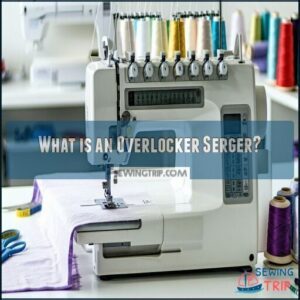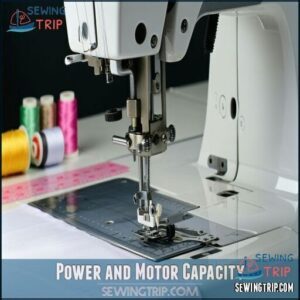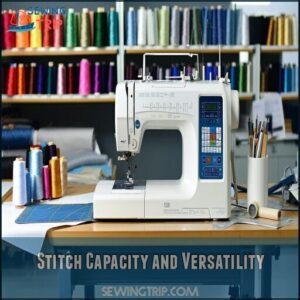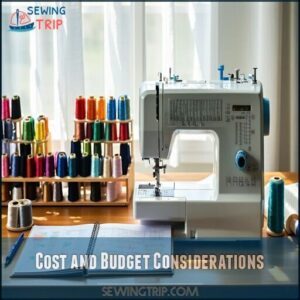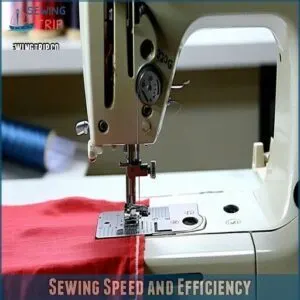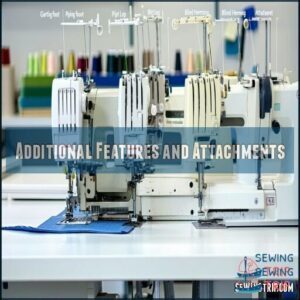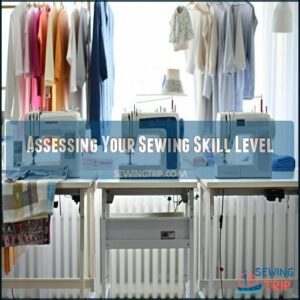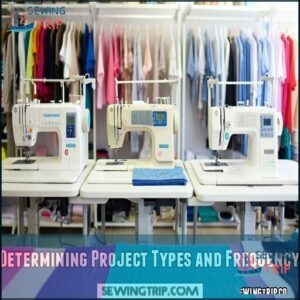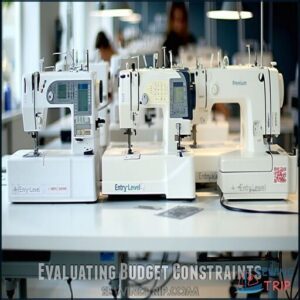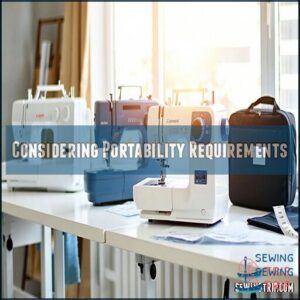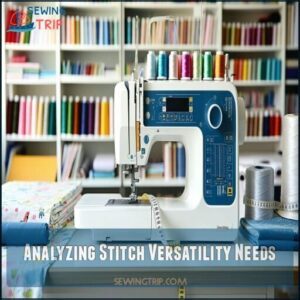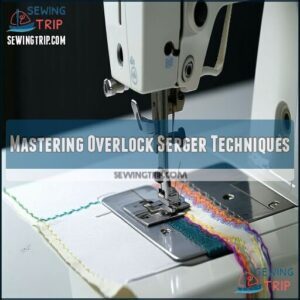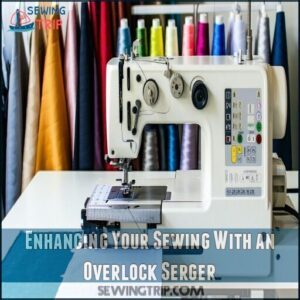This site is supported by our readers. We may earn a commission, at no cost to you, if you purchase through links.
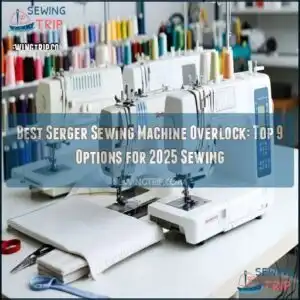 You’ll find your perfect serger in 2025’s top options like the Brother 1034D for heavy-duty work or the budget-friendly Singer S14-78.
You’ll find your perfect serger in 2025’s top options like the Brother 1034D for heavy-duty work or the budget-friendly Singer S14-78.
When shopping for the best serger sewing machine overlock, focus on thread count (3-4 is standard), differential feed for handling stretchy fabrics, and stitch width options.
The Juki MO654DE offers professional-quality stitching in a portable package, while beginners might prefer MILLEPUNTI’s user-friendly design.
Don’t forget to keep in mind speed—most quality machines deliver 1,300-1,500 stitches per minute.
Your fabric edges will thank you when you discover how these machines transform your sewing projects.
Table Of Contents
- Key Takeaways
- What is an Overlocker Serger?
- Key Features to Look for in an Overlock Serger
- Choosing The Perfect Overlock Serger for You
- 9 Best Serger Sewing Machines for Overlock Stitching
- 1. Singer ProFinish Serger 2 3 4 Thread
- 2. SINGER Stylist II Serger Overlock Machine
- 3. Brother Coverstitch Serger 2340CV
- 4. Juki MO654DE Portable Serger
- 5. SINGER X5004 HD Serger Overlock Machine
- 6. SINGER Heavy Duty Serger Overlock Kit
- 7. Brother Renewed 3 4 Thread Serger
- 8. Janome 8002D Serger
- 9. Juki MO 1000 Serger Push Button Threader
- Mastering Overlock Serger Techniques
- Enhancing Your Sewing With an Overlock Serger
- Frequently Asked Questions (FAQs)
- Conclusion
Key Takeaways
- You’ll want to pick a serger with 2-3-4 thread options, adjustable differential feed, and stitch width settings for versatility across fabric types.
- Compact and beginner-friendly machines like the Juki MO654DE or Brother 1034D are great for professional finishes while saving space.
- A serger saves time by sewing, trimming, and finishing edges at speeds of 1,300-1,500 stitches per minute, making it a key tool for faster and polished sewing.
- Features like color-coded threading guides, self-threading options, and adjustable tension make it easier to handle different fabrics and improve your sewing results.
What is an Overlocker Serger?
An overlocker, or serger, trims fabric edges while sewing them together, creating clean, durable seams that prevent fraying.
It works faster than a regular sewing machine, making it essential for professional-quality finishes and time-saving stitching.
Functionality and Stitch Types
Sergers, or overlock machines, take your sewing projects up a notch by giving raw edges a polished, professional look.
These machines sew, trim, and finish in one smooth motion, making them incredibly efficient.
Here’s why you’ll love serger stitch options:
- Versatile Stitch Types – Overlock stitches, flatlock stitching, and rolled hems cater to diverse projects.
- Professional Finishes – They create durable seams that resist fraying and stretch with fabric movement.
- Fabric Flexibility – Handle delicate fabrics like silk or sturdy materials like denim effortlessly.
With a differential feed and adjustable thread settings, a serger sewing machine offers impeccable results, enhancing creativity and efficiency with every stitch.
Thread Count and Looper Systems
Understanding looper mechanics and thread capacity can transform your overlock machine experience.
Most serger sewing machines offer 3- or 4-thread options, while advanced models handle up to 8 threads, enhancing versatility.
The loopers—upper and lower—are the unsung heroes of stitch formation.
They interlock threads around your fabric’s edge, preventing fraying and adding durability.
Machines with tubular loopers keep threads untangled, making operation smooth and frustration-free.
Threading can intimidate, but many sergers include color-coded guides to simplify the process.
For precise stitches, adjust the differential feed to match your fabric type.
Perfecting thread tension is key—numbered dials let you fine-tune tightness for different thread types.
With proper threading and adjustments, your serger sewing machine guarantees flawless, professional-quality results every time.
Speed and Efficiency Comparison
Few machines match the speed and efficiency of an overlock serger, making them indispensable for faster sewing.
With stitching speeds hitting 1,300-1,500 stitches per minute, they’re twice as fast as the average sewing machine.
You’ll breeze through hemming, seaming, and edge-finishing tasks effortlessly.
- Enhanced sewing speed and efficiency reduces your project completion time.
- Automatic features guarantee consistent stitches and smooth fabric feed control.
- Overlock machines handle professional-quality finishes without unnecessary manual adjustments.
Fabric Handling Capabilities
A serger sewing machine shines in handling a variety of fabric types. Its differential feed is a game-changer for managing stretch fabrics like knits or keeping delicate fabrics, such as chiffon, from puckering.
For smooth results when dealing with multiple layers or challenging materials:
- Adjust thread tension based on fabric weight—higher for heavy fabrics, lower for delicate fabrics.
- Use differential feed (0.7-2.0) settings to avoid stretching or gathering fabrics unintentionally.
- Match needle size to your material, like 70/10 for fine silks or 90/14 for thick denim.
- Fine-tune presser foot pressure for even stitching across varied thicknesses.
When mastered, these settings guarantee clean, professional seams and flawless edge finishes.
Ease of Use for Beginners
Feeling overwhelmed by sergers? Relax—modern beginner serger machines make life easy. Color-coded Threading Guides and automatic Tension Settings streamline setup, while self-threading features eliminate common frustrations. Plus, many include on-machine instructions or beginner-friendly video tutorials.
Here’s a quick breakdown of beginner features:
| Feature | Benefit |
|---|---|
| Color-coded guides | Faster, error-free threading |
| Self-threading | Saves time and frustration |
| Tension tips | Adjusts for smooth stitches |
Start with Simple Projects like napkins or hems. This overlock machine guide guarantees pro-like results on day one!
Key Features to Look for in an Overlock Serger
When choosing an overlock serger, you’ll want to focus on factors like motor power, stitch variety, and ease of use.
These features both impact the machine’s performance and determine how well it fits your sewing needs and skill level.
Power and Motor Capacity
The motor of your overlock machine is its powerhouse, and choosing the right one can make or break your sewing experience.
The best serger machines operate at speeds of 1,300 to 1,500 stitches per minute, ensuring smooth stitching across fabrics like delicate silk or thick denim. Look for features like adjustable power settings and vibration dampening for stable and quiet operation.
Consistent stitch quality, regardless of fabric thickness, is key for professional results. Energy-efficient sergers balance high performance with low power consumption, making marathon sessions a breeze.
- Motor Speed: Faster speeds for efficient stitching.
- Stitch Consistency: Uniform results on varied fabrics.
- Fabric Thickness: Handles lightweight to heavy materials seamlessly.
- Vibration Dampening: Reduced noise during operation.
- Power Consumption: Balanced energy use for longer sewing sessions.
Stitch Capacity and Versatility
The stitch capacity of a serger sewing machine is where true versatility shines.
With the right stitch options, you can tackle almost any sewing project confidently. A good overlock machine should offer a variety of thread combinations to handle different fabrics and finishes seamlessly:
- 2-Thread Overlock – Great for lightweight fabrics and delicate decorative stitches.
- 3/4-Thread Overlock – Perfect for stretchy knits or strong seam finishes on daily wear.
- 5-Thread Safety Stitches – Provides durability by combining overlock and chainstitch for heavy-duty projects.
Color-coded threading systems simplify switching between fabrics, making even complex designs feel straightforward.
Different models affect available stitch options. Versatility guarantees a polished finish every time.
Cost and Budget Considerations
Balancing features with budget is key when buying a serger. Consider the initial investment, maintenance costs, and thread consumption to match your project budget with long-term value.
Check serger machine prices during sales for deals. One should also consider adjustable differential feed for preventing fabric puckering.
Here’s a quick guide:
| Price Tier | Features | Best For |
|---|---|---|
| $200–$500 | Basic threads, manual | Beginners |
| $500–$2000 | Auto tension, extras | Enthusiasts |
| $2000–$4000 | Air threading, advanced | Professionals |
| $4000+ | Maximum durability | Businesses |
| Sale/Used Deals | Discontinued models | Budget buyers |
Sewing Speed and Efficiency
Sewing speed and efficiency play a big role in getting the most from your serger sewing machine.
Modern overlock machines are built to save time and produce clean results quickly.
Here’s how they enhance your sewing:
- Stitch-per-minute rates up to 1,500 for faster project completion time.
- Fabric Feed Control through differential feed guarantees smooth material handling.
- Adjustable tension dials provide precision with different fabrics.
- Automated features like air threading simplify setup.
- Efficiency techniques handle thick and delicate materials with ease.
These features elevate sewing productivity effortlessly, making it easier to work with various materials, including thick and delicate ones, and save time.
Additional Features and Attachments
The right features elevate a serger sewing machine to remarkable.
Accessories like Presser Feet, a Gathering Foot, or a Piping Foot extend versatility. Needle guards and advanced tension systems protect stitches and fabric.
Add-ons like a Blind Hemming tool or attachments for Belt Loops streamline tricky tasks. Air threading simplifies setup, while color-coded guides keep threads organized.
A differential feed maintains control over stretchy fabrics, avoiding waves. Coverstitch capabilities guarantee polished hems, and automatic needle threading spares your eyes during precision work.
These sewing machine accessories transform your overlock machine into a powerhouse designed for efficiency and creativity. Many users find that specialized feet options enhance their serger’s capabilities.
Choosing The Perfect Overlock Serger for You
Finding the right overlock serger depends on understanding your sewing goals and needs.
By considering factors like your skill level, project types, and budget, you can pick a machine that fits your workflow perfectly.
Assessing Your Sewing Skill Level
Choosing the best serger machine starts with understanding your sewing skills. If you’re just starting, look for a serger sewing machine that’s easy to thread and adjust, like 3-4 thread models.
Those with intermediate skills can handle machines with features for more stitch variety and fabric control. Advanced sewists? You’re ready for multi-thread options and advanced techniques.
- Beginner Projects: Pick machines with diagrams or color-coded threading.
- Intermediate Skills: Experiment with tension settings and differential feeds.
- Advanced Techniques: Go for sergers with customizable settings for complex designs.
Skill progression guarantees your serger choice grows with your expertise—making sewing projects a joy, not a challenge.
Determining Project Types and Frequency
When picking the best serger machine, consider how often you sew and the type of projects you tackle.
A serger sewing machine with adjustable differential feed is perfect for handling knits without creating wavy edges, while an overlock machine with automatic tension adjustment suits frequent sewists juggling various fabrics weekly.
Your project complexity also matters—light fabrics like lingerie require different capabilities than heavy denim or quilts.
Check out this quick comparison:
| Project Type | Key Features Needed | Examples |
|---|---|---|
| Knits & Stretch Fabrics | Adjustable Differential Feed | T-shirts, Leggings |
| Quilts or Thick Fabrics | Durable Build, Speed Control | Home Décor, Quilts |
| Delicate Lingerie | Fine Stitch Precision, Easy Tension | Pajamas, Undergarments |
Find a serger overlock matching your sewing time and fabric variety!
Evaluating Budget Constraints
Finding the best serger sewing machine means matching features with your budget. Prices vary widely, so understanding what you need avoids overspending.
- Entry-level sergers ($200-$300): Affordable for occasional use with basic stitching.
- Mid-range options ($300-$600): Durable machines offering better stitch variety.
- Premium sergers ($600-$1,200): Advanced features for consistent, professional results.
- Industrial-grade models ($1,200+): Built for speed and heavy usage.
Consider long-term savings by factoring in repair costs and warranties. Explore used serger value or serger machine deals online, especially during sales. Balance overlock machine price with essential features to maximize every dollar.
Considering Portability Requirements
Portability can make a best serger truly shine, especially if your workspace varies or you’re short on room.
Look for Compact Models under 15 pounds—lighter machines are easier on your back. A Travel Case with padding keeps your portable serger safe during trips.
Check Weight Limits to confirm it’s manageable for frequent moves. Prioritize features like Ergonomic Handles for comfort and stability.
If you’re considering Cordless Options, they’re ideal for flexible sewing setups. A portable sewing machine serger gives you versatility without sacrificing performance or convenience.
Analyzing Stitch Versatility Needs
After space concerns, focus on the best serger’s stitch functionality to match your projects.
Stitch versatility determines how well your sewing machine tackles fabric compatibility and project complexity.
Look for options like:
| Stitch Option | Fabric Type | Purpose |
|---|---|---|
| 2-Thread | Lightweight fabrics | Simple finish |
| 4-Thread | Stretchy fabrics | Seam durability |
| Decorative | All fabrics | Creative finishes |
Choose an overlock sewing machine with flexible stitch options to handle various projects creatively, ensuring smooth seams and durable results.
9 Best Serger Sewing Machines for Overlock Stitching
If you’re looking to elevate your sewing projects with precise, professional finishes, a top-rated serger can make all the difference.
Here are the nine best serger sewing machines for overlock stitching, designed to handle various fabrics and deliver consistent, durable seams, which can help achieve professional finishes.
1. Singer ProFinish Serger 2 3 4 Thread
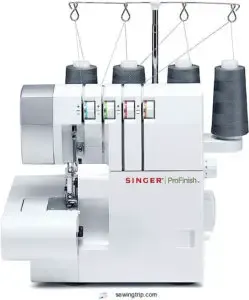
The SINGER ProFinish 14CG754 packs power and precision into a compact, user-friendly design.
It offers versatile 2-3-4 thread options, perfect for everything from lightweight fabrics to tougher materials.
With a color-coded threading system, setting up is a breeze, even for beginners.
The adjustable stitch length and width let you customize with ease.
At 1,300 stitches per minute and with a built-in fabric trimmer, you’ll get professional finishes fast.
Its free arm simplifies cuffs and sleeves, making every project look polished.
Best For: Beginner to intermediate sewists looking for fast, professional finishes on a variety of fabrics, including stretchy and tough materials.
- High speed of 1,300 stitches per minute saves time.
- Color-coded threading system simplifies setup, especially for beginners.
- Versatile 2-3-4 thread options for customized projects.
- No dust cover included for storage and protection.
- Can be fussy when adjusting to different fabric types.
- Limited warranty on adjustments, belts, and attachments.
2. SINGER Stylist II Serger Overlock Machine
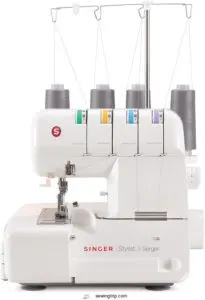
When you explore the SINGER Stylist II Serger, its sturdy heavy-duty metal frame immediately stands out, ensuring smooth, skip-free sewing for all your projects.
This serger offers 2-3-4 thread capability, making it flexible for various tasks, whether you’re finishing seams or adding decorative touches.
You’ll love the adjustable stitch length and cutting width, giving you precise control over finish and fit.
The convenient free arm design simplifies working on tricky cuffs and sleeves.
Plus, the included extra presser feet and soft protective cover only enhance its value.
Designed for durability and reliability, this machine delivers professional results and longevity.
It’s a dependable choice for sewists aiming to elevate their skills while tackling diverse sewing challenges.
The Singer brand is known for its durable and reliable machines.
Best For: Hobbyists and intermediate sewists looking for a versatile, durable serger to achieve professional-quality seams and finishes.
- Flexible 2/3/4 thread capability for various sewing projects.
- Adjustable stitch length and cutting width for precision.
- Built-in needle threader and color-coded threading paths for easy setup.
- High thread consumption may require extra purchases.
- Initial threading can be intimidating despite guided paths.
- Limited warranty and voltage compatibility to US and Canada only.
3. Brother Coverstitch Serger 2340CV
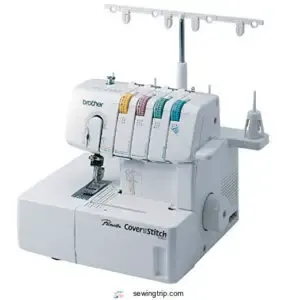
The Brother Coverstitch Serger 2340CV is your go-to machine for achieving professional hems with ease.
Its durable metal frame and impressive 1,100 stitches per minute provide reliability and speed for larger sewing projects.
This serger is perfect for stretch fabrics, ensuring flawless necklines and hems, even on bulky seams.
Key features include color-coded threading guides, tri-cover stitch options, a fast thread looper system, and adjustable differential feed (0.7-2.0mm).
Compact yet spacious, it suits beginners and pros alike, offering consistent, high-quality results.
Best For: Beginners and professionals seeking a reliable, efficient serger for stretch fabrics, necklines, and hems.
- Durable metal frame and high sewing speed of 1,100 stitches per minute.
- Easy-to-use color-coded threading system with adjustable differential feed.
- Versatile tri-cover stitch functions for professional finishes on garments.
- Threading and rethreading can be cumbersome for some users.
- Warranty void if used outside specified voltage and region.
- Limited user-serviceable parts for maintenance.
4. Juki MO654DE Portable Serger
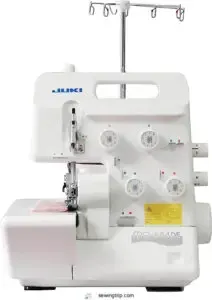
If you’re after precision and portability, the Juki MO654DE Portable Serger delivers on both fronts, making it a favorite among sewists of all levels.
Its 2/3/4 thread capability and high-speed performance (up to 1,500 stitches per minute) let you breeze through projects with professional precision.
Setting up is a breeze thanks to its color-coded threading guides, eliminating the usual threading headaches.
You’ll love the external controls for adjusting stitch length and differential feed, giving you perfect fabric handling for anything from stretchy knits to heavy upholstery.
The dedicated knife system guarantees clean, sharp cuts, while its consistent tension keeps stitches smooth and reliable.
Users often praise its quiet operation and rock-solid build for durability and performance.
Plus, maintenance is easy—just grab a paintbrush for quick cleanups.
With its thoughtful design and reliable features, the Juki MO654DE is a compact powerhouse that’s built to perform.
Best For: Hobbyists and professional sewists seeking a compact, reliable, and high-performance serger for a variety of fabrics.
- Steep learning curve for beginners.
- Requires a vacuum attachment for maintenance; no canned air allowed.
- Limited lighting may challenge users in low-light environments.
- Color-coded threading guides simplify setup.
- High-speed sewing at 1,500 stitches per minute with consistent stitch quality.
- Sturdy build and quiet operation for a smooth experience.
5. SINGER X5004 HD Serger Overlock Machine
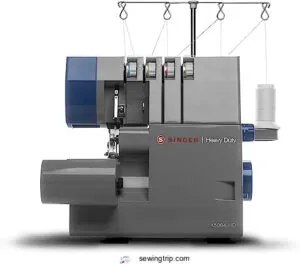
Tackling tough sewing projects doesn’t have to be intimidating.
With the SINGER X5004 HD Serger Overlock Machine, you’ll sail through even the heaviest fabrics. Its heavy-duty metal frame guarantees stability and precise stitching, eliminating skips even at high speeds of 1,300 stitches per minute.
You’ll love its versatility—choose between 2, 3, or 4 thread stitches and six built-in stitch types to handle everything from delicate silks to thick upholstery.
The cutting knife, 60% larger than standard models, cuts cleanly through challenging materials, while the adjustable differential feed prevents puckering on light fabrics.
Organized sewing is a breeze with its built-in accessory compartment, perfectly housing tools like the all-purpose foot and tweezers. It’s a durable, reliable companion to help you achieve polished, professional results every time.
Best For: Experienced and hobbyist sewists looking for a durable, high-performance serger to handle various fabric types and heavy-duty sewing projects.
- Handles thick fabrics like upholstery and denim with ease.
- Adjustable differential feed prevents puckering and handles stretchy materials well.
- Includes built-in accessory compartment for organized storage.
- May have a learning curve for beginners unfamiliar with serger operations.
- Larger cutting knife might require more careful handling.
- Limited to 8 built-in stitch types.
6. SINGER Heavy Duty Serger Overlock Kit
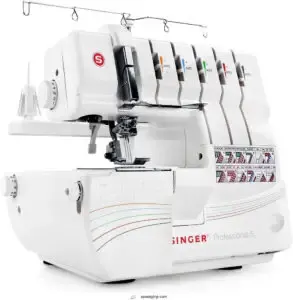
SINGER’s Heavy Duty Serger Overlock Kit stands out for its rock-solid metal frame, offering stability and durable, skip-free sewing.
You’ll love its capability to zip through projects with a remarkable 1,300 stitches per minute, making high-speed sewing a breeze. The built-in high-performance blade trims fabric edges perfectly, even when handling multiple layers.
This serger doesn’t stop at basics—it includes 4 built-in rolled hems, ensuring your edge finishes look polished and professional.
The accessory set is equally impressive, featuring multiple presser feet, needles, and tweezers to tackle a variety of sewing tasks. Whether you’re finishing seams or adding decorative touches, this machine’s versatility truly shines, making it perfect for high-speed sewing with durable results and a professional finish.
Best For: Heavy-duty sewing enthusiasts, cosplayers, and professionals seeking high-speed performance and polished results.
- Durable metal frame ensures stability and reliability.
- High-speed capability of 1,300 stitches per minute.
- Includes multiple accessories for versatile use.
- Jumpy motor with lack of precise speed control.
- Threading can be time-consuming for beginners.
- Mechanical maintenance may be needed over time.
7. Brother Renewed 3 4 Thread Serger
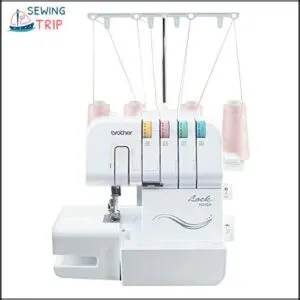
If you’re looking for a budget-friendly serger packed with versatility, the Brother Renewed 3/4 Thread Serger is a smart choice.
This machine combines affordability with professional-grade features, making it great for everything from casual sewing to customized projects.
With 22 built-in stitch functions, you can handle tasks like rolled hems, tough edges, or even decorative finishes. The color-coded threading system simplifies setup, while adjustable stitch widths (5mm to 7mm) let you customize seams to perfection.
Plus, the differential feed (0.7 to 2.0) guarantees smooth stitching on both stretchy knits and delicate fabrics.
Its LED workspace keeps things brightly lit, no matter your environment. Essential tools like snap-on feet, a foot controller, needles, and thread are included for convenience.
Designed for beginners but powerful enough for pros, this serger delivers precision and reliability without fuss, making it an all-round sewing gem.
Best For: Beginners and experienced sewists looking for an affordable, versatile serger capable of handling various fabrics and projects.
- 22 built-in stitch functions and adjustable stitch width for customization.
- Color-coded threading system simplifies setup for beginners.
- Differential feed ensures smooth, professional-grade stitching on any fabric.
- Refurbished models may have minor cosmetic issues.
- Cutting blades may require occasional replacement.
- Machine vibrations can be noticeable; additional mat accessory may help.
8. Janome 8002D Serger
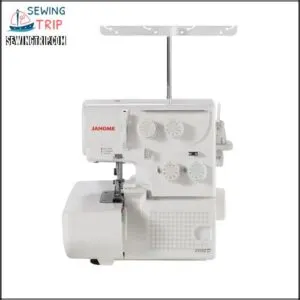
The Janome 8002D is perfect for beginners exploring serging.
Its compact size fits small spaces, while the built-in rolled hem and color-coded threading chart make setup stress-free.
Adjustable cutting widths (3.1mm–7.3mm) let you tailor stitches effortlessly.
Pre-threaded spools save time, and an instructional DVD simplifies threading challenges.
This lightweight machine reliably handles elastic swimwear and thick layers with quiet operation.
For affordable, professional results without a steep learning curve, the Janome 8002D delivers everything you’d need to start serging confidently.
Best For: Beginners and casual sewers who want an easy-to-use serger for professional stitching results at home.
- Compact design ideal for small spaces
- Color-coded threading chart simplifies setup
- Handles thick layers and elastic fabrics with ease
- Limited to 110-volt US use only
- Spool tangling and stabilization issues reported
- Pre-threading inconsistently delivered in some cases
9. Juki MO 1000 Serger Push Button Threader
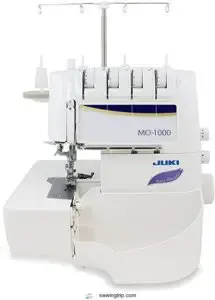
The Juki MO 1000 is a game-changer for those who value precision and ease.
Its push-button air threading system eliminates the headaches of threading loopers, getting you up and running in no time. Operating at a quiet 1,500 stitches per minute, this serger handles everything from delicate fabrics to durable materials without disrupting your focus.
With 2/3/4 thread capabilities and a built-in rolled hem feature, it adapts seamlessly to your project needs. Its powerful knife system guarantees clean, professional cuts with every pass.
While some users report minor hiccups with the air threading, the machine’s reliability and smooth performance outweigh these quirks.
For sewists wanting professional results without industrial bulk, the Juki MO 1000 is an outstanding choice.
Best For: Experienced sewists and beginners seeking a high-quality serger with easy threading and versatile stitching options.
- Effortless threading with push-button air threading system.
- Versatile 2/3/4-thread stitch configurations for diverse sewing needs.
- Quiet operation and clean professional cuts with a powerful knife system.
- Occasional reliability issues with the air threading system.
- Expensive, with high repair costs for defective units.
- Learning curve for mastering settings and adjustments.
Mastering Overlock Serger Techniques
Mastering overlock serger techniques lets you create clean edges, strong seams, and decorative finishes with ease.
By learning proper threading, tension adjustments, and troubleshooting, you’ll guarantee smooth stitching every time, which is crucial for strong seams.
Threading Your Overlock Serger Correctly
Threading your overlock serger properly can take your sewing projects from basic to polished. It’s all about following the correct threading order to guarantee smooth, reliable stitching. Always start with the lower looper, then the upper looper, and finish with needle threading.
Skipping or mixing up these steps could leave you troubleshooting threading issues for hours.
Most modern sergers offer color-coded threading paths to make this process easier. Here’s a quick checklist for success:
- Use color guides if your sewing machine serger threading includes them.
- Raise the presser foot when threading to release tension settings.
- Test your setup on scrap fabric before beginning.
If your machine has air threading for looper threading, trust it—it saves time and frustration. Follow each thread path perfectly, and you’ve got professional results waiting.
Adjusting Tension for Various Fabrics
Perfecting serger tension transforms your sewing projects.
Fabric weight and thread types play a big role in achieving balance. Lightweight fabrics need gentle looper tension, while heavy materials require tighter sewing machine adjustable settings.
Always test on scrap fabric before you start—it saves time! Adjust stitch density and use the differential feed to prevent puckering or distortion.
Well-matched sewing machine tension systems guarantee threads interlock precisely at the fabric edge. With practice, your seams will look smooth, even, and professional—every stitch a confirmation to thoughtful preparation, ensuring a perfect finish with proper adjustment.
Creating Decorative Edges and Seams
Your serger’s true potential shines when creating decorative edges and seams that transform basic projects into professional pieces.
Beyond functional finishing, your overlock machine becomes a design tool.
- Mix decorative threads for unique color blocking effects
- Create delicate rolled hemming with varying thread textures
- Add playful lettuce edging using differential feed adjustments
- Incorporate piping techniques for structured, defined edges
- Experiment with flatlock stitches for exposed seam details
These edge finishing methods elevate your work from simply "finished" to genuinely "designed." Many sewers also use blanket stitch for hems.
The best serger machines make these techniques accessible, turning ordinary seams into standout features, and enabling you to create professional pieces with ease, making your work truly unique.
Troubleshooting Common Serging Issues
Moving from decorative edges to problem-solving, you’ll find that even the best sergers occasionally need troubleshooting.
When your overlock machine gives you trouble, check these common issues:
- Skipped stitches often indicate bent or worn needles – replace them with the correct size for your fabric
- Tension problems cause uneven stitches – adjust upper and lower loopers in small increments until balanced
- Looper threading issues require following machine-specific diagrams – colors codes help prevent mistakes
- Fabric puckering suggests incorrect differential feed settings – adjust based on your material type
- Knife malfunction prevents clean cutting – inspect regularly for debris or damage
Re-threading completely often solves many problems – just remember to follow the proper order. Upper loopers first, then lower loopers, and make sure threads aren’t caught on looper arms.
Testing adjustments on scrap fabric before continuing your project will save time and frustration. For persistent issues, consulting your machine’s manual provides machine-specific solutions. This approach ensures that you can identify and fix problems efficiently, using the right troubleshooting techniques for your specific overlock machine, and following the correct procedure to avoid further issues, which is key to successful problem-solving.
Maintaining Your Serger for Longevity
A well-maintained serger can last for decades with proper care. Extend your machine’s life by establishing a regular maintenance routine—start with weekly cleaning to remove lint from loopers and feed dogs.
Use a small brush to reach those tight spaces where thread bits accumulate. Apply oil monthly to moving mechanisms, following your manufacturer’s guidelines for proper lubrication points.
Don’t overlook tension adjustments when switching between fabrics, as proper settings prevent unnecessary strain on your machine. Replace needles every 8-10 hours of sewing time—dull needles cause thread breaks and skipped stitches.
Keep your serger blades sharp, scheduling blade replacement when you notice frayed rather than clean cuts. Store your machine covered in a dry place with the presser foot down to prevent dust buildup.
Consider professional servicing annually, especially for complex models with air threading systems or differential feed features. Your serger’s longevity depends on these simple but essential sewing machine maintenance practices.
Enhancing Your Sewing With an Overlock Serger
You’ll transform your sewing projects from homemade to professional-looking with an overlock serger that speeds up your workflow while creating durable, clean-finished edges.
These specialized machines work alongside your traditional sewing machine to enhance seam quality and expand your creative possibilities with knits, delicates, and a variety of fabrics.
Complementing Traditional Sewing Machines
Combining the best serger with your traditional sewing machine creates the perfect sewing team. Your sewing machine constructs garments with precise stitches and decorative elements, while your overlock machine provides professional seam reinforcement and edge finishing at double the speed.
This project integration streamlines your workflow—the sewing machine builds the structure while the serger creates clean, durable edges. With both machines properly threaded for their specific purposes, you’ll enjoy an efficiency boost that transforms simple projects into professional-quality creations.
The fabric versatility of both machines working together lets you tackle nearly any sewing challenge with confidence, allowing you to create a wide range of items with professional-quality results.
Expanding Your Project Possibilities
Your overlock machine opens doors to projects that traditional sewing machines struggle with.
Expand your creativity—experiment with knits, delicate fabrics, and mixed materials effortlessly using your overlock serger.
After mastering basic functions, you’ll find your best serger transforms simple ideas into professional creations.
- Fabric Combinations: Blend knits and wovens with secure, stretchy seams
- Pattern Alterations: Modify designs confidently with clean finishes
- Mixed Media: Join leather to cotton or denim to lace without puckering
- Home Decor: Create professional-looking pillows, curtains, and table linens
- Creative Embellishments: Add decorative threading and rolled edges
Sewing projects that once seemed intimidating—like swimwear, activewear, and delicate fabrics—become accessible with your serger’s specialized capabilities.
Sewing machine limitations disappear as serger reviews highlight these expanded possibilities.
Improving Garment Construction Quality
While exploring new project possibilities is exciting, the true transformation happens in your finished garments.
A serger machine takes your garment construction from homemade to high-end with professional finishes that instantly upgrade your creations.
Your handmade items will showcase quality that rivals store-bought pieces through:
- Perfect edge neatness with clean, rolled hems that prevent fraying and extend garment life
- Consistent stitching that maintains even tension across different fabric types
- Fabric stabilization that prevents stretching or distortion on knits and delicates
- Seam durability that withstands repeated washing and wearing
Your overlock machine creates invisible seams that lie flat against the body without bulky edges.
Techniques like differential feed eliminate puckering on stretchy fabrics, ensuring everything fits perfectly.
With proper tension settings, you’ll achieve professional finishes that make friends ask, "Where did you buy that?
Increasing Sewing Productivity
After perfecting your garment construction quality, you’ll notice a remarkable shift in your sewing productivity when introducing a serger machine into your toolkit.
Your productivity skyrockets with an overlock machine’s impressive capabilities. Modern sergers operate at blazing speeds of 1,500 stitches per minute, nearly twice as fast as standard sewing machines.
With proper time management and an ergonomic setup, you’ll transform your sewing efficiency. To further improve efficiency, consider pre-production planning to identify critical processes. The serger’s ability to cut and finish edges in one pass enables batch sewing techniques that weren’t previously possible.
Many sewists report completing projects in half the time, making these machines invaluable for mass production or minimalist techniques.
Exploring Advanced Serging Applications
Now that you’ve gained speed with your serger, it’s time to discover its hidden talents.
Your serger can do so much more than basic seams. Take your projects to professional levels with these advanced techniques:
- Create stunning ruffles by adjusting differential feed settings
- Add decorative flatlock stitching for visible seam details on activewear
- Produce perfect lettuce-edge hems on stretchy fabrics
With proper maintenance, your overlock machine becomes a true fabric finishing powerhouse. You can even explore serger decorative options to add unique touches. These industrial serging techniques will transform ordinary projects into boutique-quality creations that look store-bought.
Frequently Asked Questions (FAQs)
What is the best serger on the market?
According to recent reviews, the JUKI MO654DE Portable Thread Serger is considered the best overall serger on the market.
You’ll appreciate its automatic rolled hem capability and impressive 1,500 stitches per minute speed.
Can you do an overlock stitch on a serger?
The overlock stitch is a serger’s bread and butter.
You’ll find this is exactly what sergers are designed for – creating finished edges that prevent fraying while trimming excess fabric simultaneously.
What is the difference between a serger and an overlock serger?
There’s no difference between a serger and an overlock serger – they’re the same machine.
You’ll hear both terms used interchangeably.
Both trim fabric edges while creating stitches that prevent fraying.
What is the easiest overlocker to use?
Wondering which overlocker won’t leave you tangled in threads?
The Babylock sergers with Jet Air Threading are the easiest to use, followed by Juki models with their semi-automatic threading systems and color-coded guides.
Is there a serger and sewing machine in one?
You’ll find combo machines that offer both functions, but they’re limited.
Most sewers prefer separate machines for better performance.
Brother offers some feature-rich sewing and embroidery combos, but true serger-sewing hybrids are rare.
Is it worth buying a serger?
Like threading a needle to transform your sewing game, a serger is worth buying.
You’ll get professional-looking seams, faster project completion, and better handling of stretchy fabrics for more polished results.
Who makes the best quality serger?
Babylock stands as the gold standard for sergers, offering premium features like Jet Air Threading and automatic tension.
Juki follows with durable, reliable models at mid-range prices, while Brother provides quality entry-level options.
What is the best brand for sergers?
Juki, Babylock, and Brother lead the serger market.
Juki offers durability and precision, Babylock excels in advanced features and ease of use.
Brother provides affordability and simplicity, making it great for beginners.
What is the best overlock stitch on a sewing machine?
Seeking the perfect stitch?
Your best overlock option is the four-thread overlock.
It gives you superior durability and strength for seams, while providing excellent flexibility for various fabrics you’ll work with.
How often should I clean my serger?
Clean your serger after every major project or about 8-10 hours of use.
Remove lint, thread bits, and dust using a brush or vacuum.
Regular cleaning keeps stitches consistent and your machine running smoothly.
Conclusion
Finding the best serger sewing machine overlock doesn’t have to be a stitch in time-saving confusion.
Assess your sewing level, project goals, and budget, then match those needs to features like thread count, stitch speed, and ease of use.
Whether you’re drawn to the reliable Brother 1034D or the sleek Juki MO654DE, there’s an option for everyone.
With these top picks, you’ll add professional, polished edges to every project, and your creativity just met its perfect match.

